Flexible PCB Manufacturing Services
One-Stop Solution for Flexible Circuits
Single-sided Flexible PCB | Double-sided Flex PCB | Multilayer Flexible Circuit Boards | Flexible PCB Fabrication | Flex PCB Assembly
Flexible PCB prototype manufacturing
Fast Fabrication | 24 Hours Expedite Delivery | Low Cost
Home » PCB Manufacturing » Flexible PCB
Are you Looking for FPC Manufacturer?
If you need a manufacturer who can manufacture flexible PCBs for you, you should make it clear that this PCB Manufacturer should have a mature and current process flow for manufacturing flexible circuit boards. Considering factors such as manufacturing cost, we suggest that you choose a Chinese FLEX PCB manufacturer. Because, at present, the PCB Manufacturing industry is basically concentrated in China. It is not only because China’s manufacturing industry is very developed, but also because it has a very mature production process and can effectively reduce the cost of manufacturing products for you. To visit our factory, please click here.
Everything You Must Know About Flexible PCB
What is Flexible PCB?
What Are Flexible Circuit Boards ?
Flexible PCB Definition, For a new product to be better applied, we need to understand exactly what it means and everything about it. Flexible PCB, also known as flexible electronics, flexible circuit board, Flex PCB, Flexi board, flex circuits.
JHY
Flexible Circuit Boards, as the name suggests, are special types of circuits that can bend and adjust to the shape of the device and product in which they are installed. They are made of a flexible substrate and have the capability to adapt according to the shape.
Physically, you can consider flexible printed circuit (FPC) boards just like a PCB with components, but the only difference is that the substrate can be bent. The same components can be mounted on an FPC, and the same functionality can be obtained just like a normal rigid PCB.

There are special plastic substrates used to make a flexible circuit board. It could be Polyimide or polyester film. Sometimes, you will see a polyester sheet and silver conductive lines on it; We will introduce in detail later on Which material is used in flexible PCB.
These circuits are used in special projects when you care more about the compactness and minimalist design of the product. It has greatly revolutionized the electronics industry and has significantly reduced the size of products or devices.
The Benefits of Flexible PCB
What are Advantages of Flexible PCB ?
Custom flexible PCBs are becoming more and more popular, we need to understand the benefits of using Flexi circuits.
Flexible PCBs have many advantages, and that is why they are used in many places. In some cases, it is necessary to use FPCs. Let’s have a look at some of the most important advantages of FPCs.
FPCs can easily bend and take the available space; therefore, they save a lot of space and help in making the final product more and more compact. In contrast, you need a dedicated space for rigid PCBs, and they cannot bend at all. Even a flexible board can be installed in multiple levels and can be connected through flexible circuits.
The circuit or conductive lines on the board are quite thin, and the same goes with the insulating material or dielectric. These things make the circuit much lighter in weight.
FPCs are more reliable as there are fewer joints and wire connectors on the board. Usually, there is no need for a wire connector as flexible circuits are more than enough. It makes the PCB more stable and reliable. Moreover, the PCB can bear vibrations and shock because it has the ability to bend, so it is more reliable, and there are fewer chances of failure. It offers excellent durability, high density, high heat dissipation, and long-term performance.
Flexible circuits are compatible with almost all types of components and connectors and can be used in almost all types of applications and devices. Therefore, it is the most compatible type of circuit.
Its performance is also commendable. It can bear extreme temperatures up to 400ᵒC. Moreover, it also prevents reactions with air, acids, and chemicals in the area.
Flexible circuits help you to have cost control because they are more reliable and stable. There are fewer chances of errors, and the cost of component replacement and re-working is saved. Moreover, it can easily fit in any available area, which reduces the overall assembly cost.
These benefits make flex PCBs ideally fit for a wide range of applications in industries such as Military, Transportation, Medical, Consumer Electronics, Automotive, Aerospace, Communications and Industrial.

The benefits of flexible circuit boards
What Are Flexible PCBs Used For?
Flexible PCB Applications
Flexible PCBs are used for hundreds of applications that require flexibility, compactness, and reliability. It can adopt any available space and has advantages that other types of PCBs don’t have, so it is used in many applications.
- Interconnectors
- Automotive
- Medical Equipment and Devices
- Industrial Electronics
- Gadgets and Phones
- Aerospace
- Consumer Electronics
- Learn More
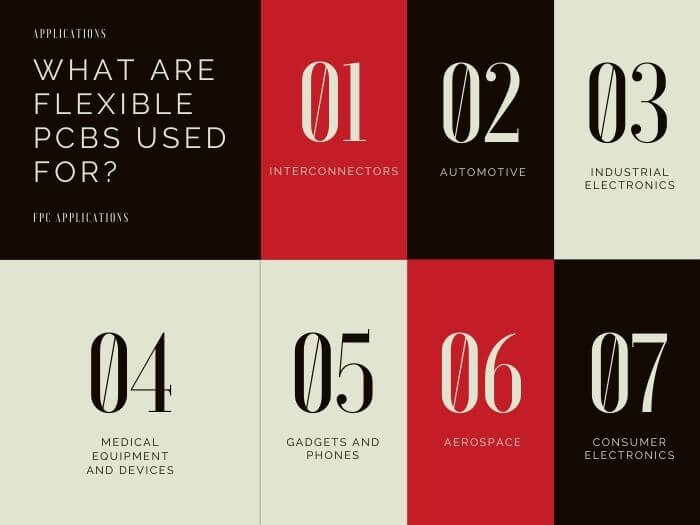
Flexible PCB Applications


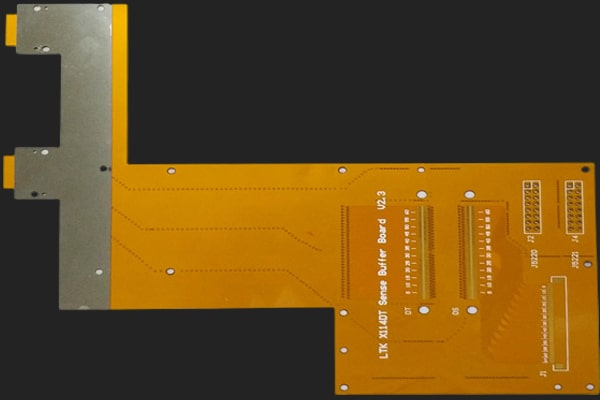


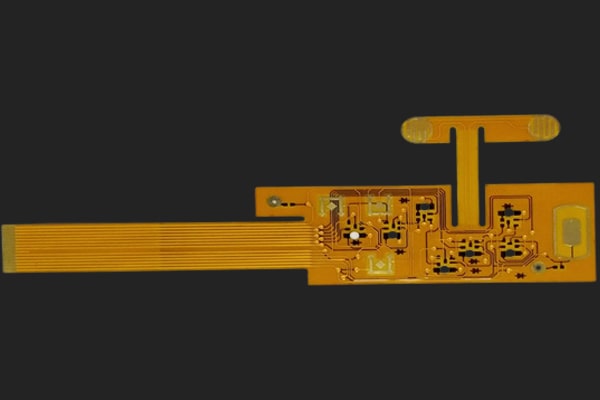







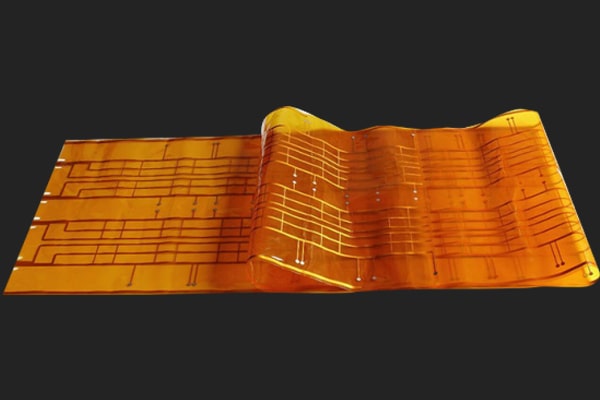





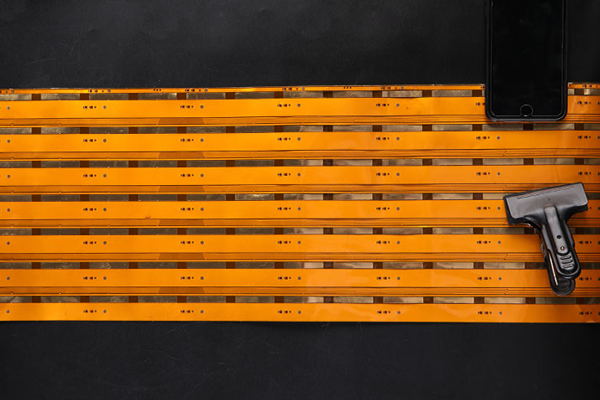
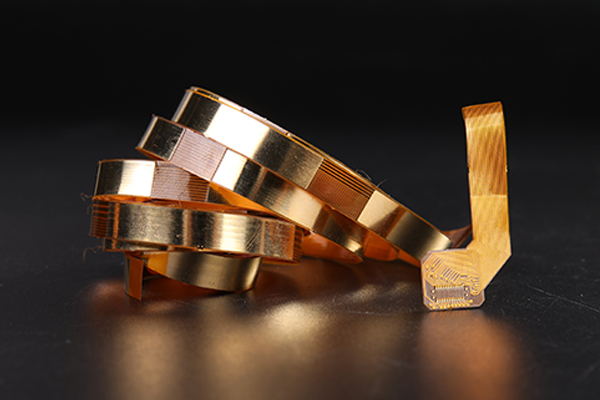
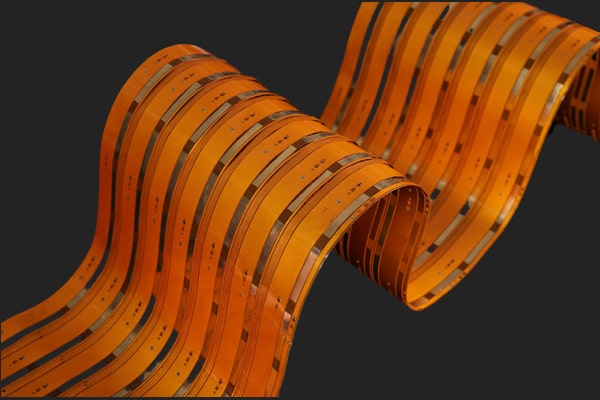
Flexible PCB Fabrication Service
Flexible Circuit Fabrication Service
JHY is a reliable flexible PCB manufacturer with over 10 years of experience manufacturing and assembling high-quality flexible circuits.

As a leading and reliable prototype to mass production flexible PCB manufacturer in China, we have flexible PCB capabilities that other manufacturers can’t compete with. We also offer quick-turn flexible circuit prototyping services.
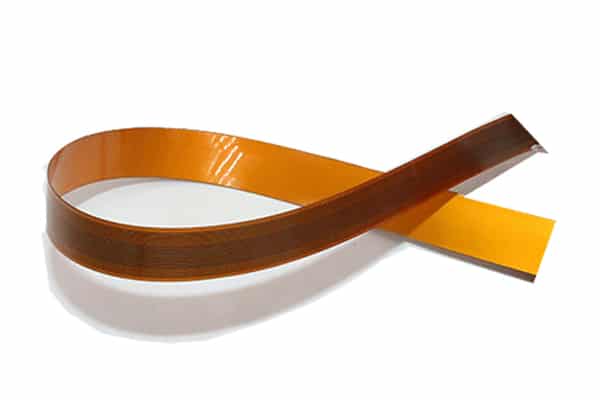
The single-layer flexible PCB has the simplest stack up. At the bottom, there is the base layer of Polyimide or any other flexible material. Then we have adhesive and, after that, the copper layer. This is the simplest stack-up. The copper layer is not left alone; a protective film called flex coverlay is applied. This protective film is made of Polyimide along with an adhesive.

The middle layer is made of flexible insulating material, which is the base. Then, there are copper layers on both sides, along with an adhesive. Finally, the copper on both sides has a coverlay.

Multilayer FPCs are the combination of single and double-sided FPCs. In the middle, we have double-layer FPCs, just like a polyimide layer sandwiched between copper layers. The surface layers have one copper layer, and there is a protective coverlay at the top and bottom.

Rigid-flex PCBs are new creative types of PCBs that own the convenience of rigid PCBs and the high flexibility and adaptability of flexible PCBs. Among all PCBs, rigid-flex can withstand seriously tough application environments, favored by high-end industrial control and the medical industry. Rigid-flex PCBs differ from the original flex and rigid board in raw material and manufacturing processes. Rigid-flex PCBs own the advantage of both rigid FR4 PCBs and flexible PCBs.
Read More: What Are The Advantages And Applications Of Rigid-Flex PCBs?

A Special Process For Flexible PCB Fabrication.
Flex Circuit Coverlay is a protective film, also known as cover film, to protect the external circuit. The internal circuit is safe and does not need protection, but the external circuit is prone to oxidation and reactions. Thus, there is a need for a cover, and Flex Circuit Coverlay provides it.
Flex Circuit Coverlay is made of Polyimide along with an adhesive. After placing the coverlay on the circuit, it is pressed through heat and pressure. Therefore, it sticks to the board and works as a protective film.
Read More: The Manufacturing Process Of Double-sided Flexible PCB Coverlay

JHY provides highly reliable flexible printed circuit assembly services, whether single-sided flexible PCB, double-sided flexible PCB, multi-layer flexible circuit, or rigid-flex PCB board. Our one-stop turnkey flexible PCB assembly solution includes DFM, DFT, DFA, prototype, production manufacturing, manual and automated assembly, surface mount technology or through hole technology, Supply Chain Management, testing, and Technical Support.
Read More:
Flexible PCB Manufacturing Process
How To Make Flexible PCB?
FPC is divided into four types: single-layer flexible PCB, double-sided flex PCB, multi-layer Flexi PCB, and rigid-flexible PCB board. There are two basic processes for manufacturing a flexible printed circuit: subtractive and additive. It is mainly made of polyimide or polyester film as the basic material. Other components include insulating film, conductor, and adhesive.
Learn more about Knowledge of Flexible Printed Circuit Board Processing Technology

Flexible PCB Fabrication Process Flowchart
Capabilities
Flexible Circuit Fabrication Capability
JHY is an expert in the field of manufacturing flexible circuits. The following are our capabilities when it comes to Flexible Circuit Boards:
- Up to 10 layers
- Roll-to-Roll Manufacturing
- Variety of Copper thickness options (1/3oz – 2oz)
- Micro-vias (filled)
- Electroplated Nickel/Gold
- Electroless Nickel Immersion Gold (ENIG)
- Immersion Silver (ImAg)
- Shielding Film Application
- Electrical Testing
- Stiffeners
- Min. PTH size: 0.1mm
- Finished Board Thickness: 0.05mm-1.6mm
- Laminate: DuPont PI, Shengyi PI
- Additional options available
What are the differences between Flex and Rigid boards?
Rigid vs Flex PCB: What Is The Difference?
Flexible printed circuits are quite different than rigid PCBs:
- Materials: Rigid PCB is typically made from glass-epoxy compounds (FR-4), while flexible circuits are made from polyimide. There are cases when rigid PCB boards are built with polyimide, but it isn’t as common.
- Coverlay: Flexible PCBs either have a flexible mask or coverlay while rigid PCBs typically just use a solder mask.
- Stiffeners: Flexible PCBs typically use FR4, steel sheet, or polyimide stiffeners to stiffen specific non-flexing regions. Stiffeners are either laminated to the flex or adhered to using a PSA (pressure-sensitive adhesive). Rigid PCB boards do not need stiffeners.
- Permittivity: There is a wide range of relative permittivity (dielectric constants) for rigid PCB board materials, while flexible polyimide material is typically 3.4.
- Read More
Materials for Flex Circuits Fabrication
Flexible PCB Materials
Flexible PCB requires three materials to be ready for operations. The three materials are the base, adhesive, and metal foil.
Base material
The base material of any PCB is the most important one because it makes the PCB what it is. The flexible circuit is flexible because of the base material.
The base material acts as the dielectric or insulator. The conductive layers are created around it. It is basically the whole foundation of the PCB on which the components and conductive layers lie.
FPCs are usually made of Polyimide, and it is the most used base. Then, there is a polyester film which can also do wonders. However, we have more materials to be used as the base of a flexible circuit, and they are polyetherimide (PEI), polyethylene naphthalate (PEN), and various fluropolymers (FEP) and copolymers.
Nowadays, most flexible circuits are made of Polyimide because it has good flame resistance.Bonding adhesive
We have an insulating layer, which is the base. Over it, there is a conductive base made of copper. These two are joined with the help of a bonding adhesive.
We have also discussed flex circuit coverlay and learned that adhesive also plays an important role in it.
There are two types of adhesives commonly used in the flexible circuit, and they are Acrylic and Epoxy. Acrylic adhesives have excellent heat resistance properties, but they have poor electrical properties. Moreover, they do not have good binding strength. On the other hand, Epoxy is a little lower in heat resistance, but its electric performance and bonding capabilities are good. The storage time of Acrylic is more than Epoxy. It can last for a longer time. In contrast, Epoxy keeps reacting, so it can’t be stored for a long time.
While selecting a good bonding adhesive, there are a few things the manufacturers consider, and they are flexibility, adhesion, electrical properties, and chemical inertness.Metal foil
Metal foil is the one that conducts the electricity and creates the whole circuit. It is applied on the base using an adhesive, and after that, it is etched to get the circuit pattern. Usually, copper is used for this purpose because it is inexpensive and has excellent electric properties. There are different grades and types of copper foils available, and manufacturers use them according to their needs.
The thickness of copper is selected by the buyer. We can divide copper foil into two main categories: Rolled Copper Foil and Electrodeposited Copper Foil. For flexible PCBs, Rolled Copper Foil is used. Copper foil is made according to the needs. It is treated to enhance its peeling strength, oxidation resistance, and roughness.
Copper foil: divided into two types: electrolytic copper and rolled copper. The standard thicknesses are 1oz 1/2oz and 1/3 oz.
Substrate film: There are two standard thicknesses: 1mil and 1/2mil.
Glue (adhesive): The thickness is determined according to customer requirements.
Cover Film: for surface insulation. Typical thicknesses are 1mil and 1/2mil.
Stiffener Film (PI Stiffener Film): Reinforce the mechanical strength of FPC to facilitate surface mounting operations. The typical thickness is 3mil to 9mil.
EMI: Electromagnetic shielding film protects the circuit board’s circuit from outside interference (strong electromagnetic area or susceptible to interference area).
In certain non standard cases, the circuit manufacturer may be called upon to create a specialty laminate by using a specified alternative metal foil, such as a special copper alloy or other metal foil in the construction. This is accomplished by laminating the foil to a base film with or without an adhesive depending on the nature and properties of the base film.
Advanced Learning
Is the cost of manufacturing flexible PCBs high?
Flexible PCBs are widely used due to their excellent physical and electrical properties. However, flexible PCBs’ manufacturing cost and price are still several times that of rigid PCBs. Many factors affect the price of FPC flexible circuit boards, such as material, manufacturing process, number of layers, quality, surface finish, copper foil thickness, size, delivery time, quantity, etc. Here we have listed 16 factors that affect the price of flexible PCBs.
IPC standards for flexible circuit board manufacturing
| No. | IPC Standards Serial Number | Name | Description |
| 1 | IPC-4203 | Cover and Bonding Material for Flexible Printed Circuitry | This standard is for the cover and bonding material, as the name states. The cover refers to the base material, and bonding is the adhesive used to bind the metal foil and the base. The standard does the classification of the dielectric films along with an adhesive. It also discusses the quality requirements and qualifications. Note: It only discusses the flexible circuits covers and adhesives. |
| 2 | IPC-4204 | Flexible Metal-CladDielectrics for Use in Fabrication of Flexible Printed Circuitry | This standard classifies the flexible metal-clad dielectric materials and discusses the quality requirements. These are the materials used for the fabrication of flexible printed boards. |
| 3 | IPC-6013 | Qualification and Performance Specification for Flexible/Rigid-Flexible Printed Boards | This is a special specification for the qualification and performance of FPCs that are designed according to IPC-2221 and IPC-2223. |
| 4 | IPC-FC-231C | Flexible Base Dielectrics for Use in Flexible Printed Wiring | Revision C, April 1992. |
| 5 | IPC-FC-241 | Flexible Metal-Clad Dielectrics for Use in Fabrication of Flexible Printed Wiring | We have discussed metal-clad dielectrics. This standard discusses these dielectrics for flexible printed wiring. |
| 6 | IPC-2223 | Sectional Design Standard for Flexible/Rigid-Flexible Printed Boards | This standard is all about the design of the flexible and rigid-flex PCB. It highlights the specific requirements and discusses component mounting forms and interconnecting structures. |
| 7 | IPC-ML-990 | Performance Specification for Flexible Multilayer Wiring | 1972 Edition, September 1972. |
| 8 | IPC-FC-250A | Specification for Single- and Double-Sided Flexible Printed Wiring | This is a specification of flexible printed wiring. The wiring has the conductor patterns on a flexible base. There can be stiffeners and interfacial connections. |
| 9 | IPC-RF-245 | Performance Specification for Rigid-Flex Printed Boards | IPC-RF-245, 1987 Edition, April 1987. |
JHYPCB: A Leading Flexible PCB Manufacturer from China
JHYPCB is a leading PCB manufacturer that can manufacture almost every type of PCB, including flexible PCB. We can handle low to high volume orders and offer a fast turnaround. Our strict quality management system ensures optimal performance and safety. We are RoHS, ISO, and UL certified, and we take care of the international standards.
We can offer almost all PCB services, including flexible circuit prototypes and complete assemblies. Our reasonable prices, fast turnaround, and expert guidance are perfect for startups and small businesses. We offer a complete PCB solution under one roof.
For more information and details, feel free to contact our customer support team.
Here are some videos you might be interested in
FAQ
Most frequent questions and answers
Yes, we make single layer flexible PCB, double sided flexible PCB, multi-layer flexible PCB, and Rigid-Flex PCBs.
We make different types of Flex and Rigid-Flex PCBs, depending on the structure, base material, adhesive, appearance, insulation base film, and metal conductor foil. Please consult our technical team for details suitable for your application.
Yes, we provide black PI stiffeners, yellow PI cover films, transparent polyimide films, white overlay, and brown PI copper clad laminates.
Yes. We have four manufacturing methods for adhesive-free copper foil base materials. We use spray plating, curtain coating, electroless deposition/electrolytic plating, and laminating.
Minimum thickness is 2 µm and the maximum is 200 µm. We ensure high chemical durability and processing compatibility for flexible printed circuits and do not sacrifice its original electrical property, heat-resistant property, and mechanical property.
IPC Standards for Rigid and Flexible PCBs
The list of IPC standards below applies to rigid PCBs and flex circuits. Take note that this list is not exhaustive, and additional IPC standards may need to be considered. You should consult the ipc.org website for a full list of available IPC standards.
- IPC-2221A, Generic Standard on Printed Board Design
- IPC-2223, Sectional Design Standard for Flexible Printed Boards
- IPC-4101, Specification for Base Materials for Rigid and Multilayer Printed Boards
- IPC-4202, Flexible Base Dielectrics for Use in Flexible Printed Circuitry
- IPC-4203, Adhesive Coated Dielectric Films for Use as Cover Sheets for Flexible Printed Circuitry and Flexible Adhesive Bonding Films
- IPC-4204, Flexible Metal-Clad Dielectrics for Use in Fabrication of Flexible Printed CircuitryIPC-6013, Qualification and Performance Specification for Flexible Printed Wiring
The functions of flexible circuit boards can be divided into four types: Lead Line, Printed Circuit, Connector, and Integration of Function. The use covers computers and computer peripherals—auxiliary systems, consumer electrical appliances, automobiles, etc. After the circuit is completed with single-sided PI copper-clad material, it is covered with a protective film to form a flexible circuit board with only a single-layer conductor.
As the name suggests, rigid-flex PCB is a mixture of rigid and flexible PCBs. Rigid-flex PCBs combine the excellent qualities of both while eliminating many of their limitations. Rigid-flex PCBs combine flex circuit design with rigid materials.
By layering the flexible PCB board inside the rigid printed circuit board material, the versatility of the flexible printed circuit is finally combined with the stability, strength, and circuit wiring density of the rigid printed circuit board. This mixing opens possibilities for more complex and mechanically challenging rigid-flex PCB designs.
Rigid-flex PCB simplifies the electronic design by eliminating flexible cables, connectors, and discrete wiring. Its electrical performance has been enhanced compared to its counterparts because the circuit is an integral part of the overall structure. All electrical and mechanical connections are contained in the rigid-flex PCB, providing electronic designers with greatly improved service reliability and electrical performance.
Although the cost of rigid-flex PCBs is usually higher than flexible PCBs and rigid PCBs. However, rigid-flex PCBs’ reliability, weight reduction, strength, and space-saving advantages are generally ideal in specific applications and are superior to any other electronic packaging technology. Ultimately, rigid-flex PCB provides the best benefits of rigid PCBs and flexible PCBs in one solution.
- Step 1: Submit or Send your PCB files (Gerber) and requirements to sales@pcbjhy.com, and our customer support will reply you within 2 hours.
- Step 2: You will get the official quotation from JHY within 12 hours.
- Step 3: Place your order and our enginner will review the Gerber and comforming you with the EQ, and then, the production will start.
- Step 4: Quality check and arrange the shipping by courier.
Recommended PCB Manufacturing Services
Related articles
- Five factors that FPC PCB designers should know about impedance control
- Key Process Flow of Rigid-Fled PCB Production
- Knowledge of Plating on Flexible Circuit Board Surface
- The Terms Related to The Flexible PCB Board Manufacturing
- What Is FR-4 Material In PCB Fabrication?
- Development and Applications of FPC Flexible PCB
- Flexible Printed Circuit For Today’s Packaging
- Why is Flexible PCB so Expensive?
- How To Select The Right Flexible PCB Manufacturer For Your Product: A 6-Step Guide
- Flexible PCB Manufacturing: A Guide To Fabrication And Assembly








